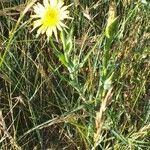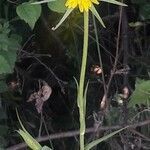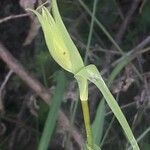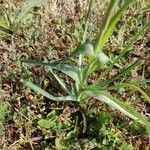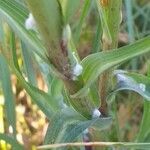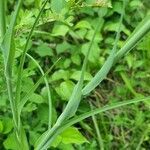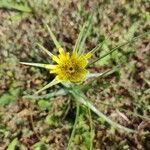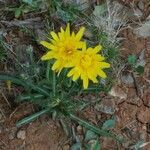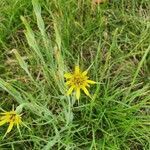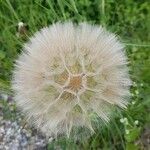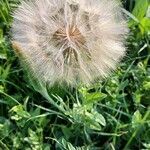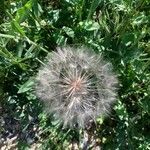Biennial with cylindric rootstock. Stems erect, weakly ribbed, glabrous, 30-80 cm tall. Lvs linear to lanceolate-subulate, entire, acuminate, 5-20 × 0.5-1.5 cm; base sheathing; margins undulate or flat. Capitula solitary; peduncles swollen beneath capitula (> 5 mm thick at fruiting). Involucre with a band of sparse minute crisped hairs at base; involucral bracts c. 8, lanceolate-acuminate, 4-6 × 0.5-1 cm at fruiting, glabrous or with fine tomentum near apex. Corolla yellow, < involucre. Achenes fusiform, ribbed, the outer coarsely muricate to spinulose, the inner almost smooth; body 12-15 mm long; beak 1-1.5× length of body, distinctly clavate at apex. Pappus sordid, 2-2.5-(3) cm long, plumose, in 2 rows, seated on a distinct tomentose annulus.
Biennial herb up to 1 m tall, sparingly branched from the base, stems thick (up to 6 mm diam.), loosely white woolly at first, soon glabrous, or wisps persisting at the leaf bases, leafy throughout. Leaves grass-like, up to c. 25 x 1.5 cm, linear-lanceolate, long-acuminate, base broad, half-clasping, margins entire, glabrous or with white wool in the leaf axils. Heads 8-12 cm across in fruit, solitary on long peduncles much inflated at the top. Involucral bracts (8-)13(-17), lanceolate-acuminate, 5-6 cm long in fruiting heads. Flowers yellow, shorter than the involucre. Achenes up to 3.5 cm including the beak, body of the achene strongly muricate on the ribs. Pappus of whitish plumose bristles.
Herbs 40-80(-100) cm tall, biennial. Stem erect, simple or branched from lower or middle third, glabrous. Basal and lower cauline leaves lanceolate to linear, 15-40 × 0.3-0.5 cm. Capitula solitary to few; peduncle inflated, 7-10 mm in diam. Involucre 4-5.5 cm at anthesis, to 7 cm in fruit. Phyllaries 8-12(-14), longer than florets, equaling or longer than achenes with pappus. Ligules yellow. Outer achenes 2.2-3 cm; body pale brown, ± curviform, 1.4-1.7 mm in diam., with 5 fairly well-differentiated ribs, tuberculate; beak whitish, 1.2-1.6 cm, slender, non-tuberculate or toothed, apically inflated; pappus disk pubescent. Pappus dirty white, 2.2-2.8 cm. Fl. and fr. Apr-Jun. 2n = 12.
Biennial herb, up to 1 m high; with milky latex, loosely white-woolly at first, soon glabrous, or wisps of wool persisting at leaf bases. Leaves alternate, sessile; blade grass-like, linear, apex long acuminate, base broad, half-clasping, margins entire, glabrous or with white wool in leaf axils. Heads ligulate, solitary, long pedunculate. Involucral bracts uniseriate, usually (8-)13(-17), subconnate at base. Receptacle epaleate. Flowers: ligules shorter than involucral bracts, yellow; Nov.-Mar. Fruit with cypsela fusiform, terete, ribs muricate, narrowed upwards into long beak. Pappus of plumose bristles.
Grass-like, biennial herb, up to 1 m high, with milky latex. Leaves alternate, linear-lanceolate, long acuminate, base broad, amplexicaul, margins entire, glabrous or with white wool in leaf axils. Capitula ligulate, solitary, terminal, long pedunculate; involucral bracts in 1 row, usually 13, sometimes more, occasionally 8. Florets yellow, corolla shorter than involucral bracts. Flowering time Sept.-Jan. Pappus of plumose bristles. Cypselae fusiform, strongly ribbed and muricate, narrowed upwards into a long beak.
A herb that takes 2 years to complete its life cycle. It is like a large dandelion. In grows 20-60 cm tall. It is very similar to Salsify except it has yellow flowers. The flower stalks are strongly inflated below the flower heads. There are 8-12 flower bracts. The flower heads occur singly and are 3-5 cm across. The fruit is a narrow long-beaked achene.
Plants (30–)40–80(–100) cm. Leaves: apices straight (not recurved to coiled), faces initially tomentulose to floccose, soon glabrescent. Peduncles distally inflated. Involucres conic in bud. Outer florets much shorter than phyllaries; corollas yellow. 2n = 12.
Biennial herb, up to 1 m high. Involucral bracts usually 13, sometimes more, occasionally 8. Achenes all with plumose pappus bristles. Flowers yellow.
